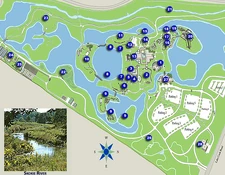
Inside the Chicago Botanic Garden; view of a lake and different flora.
The Chicago Botanic Garden (385 acres) is a botanical garden located at 1000 Lake Cook Road, Glencoe, Illinois. It is open daily except Christmas Day. Admission is free for members.
The garden is operated by the Chicago Horticultural Society, founded 1890, for collections, education, and research. Its ground-breaking was in 1965, with the official opening in 1972.
Today the garden contains some 2.2 million plants representing 8,310 taxa, displayed in landscape settings. One-third of the site is devoted to horticultural display; another third is native habitats; and the remaining third is lakes and facilities. Its 26 major gardens and natural areas are as follows:
- Aquatic Garden - waterlilies and lotuses.
- Bulb Garden - a fine display of flowering bulbs.
- Children's Garden - garden beds for children, with evergreen maze and prairie garden.
- Circle Garden - a formal garden of annual flowers, with flowering trees, evergreens, and shrubs.
- Dixon Prairie - restored prairies (15 acres), featuring six prairie types once common to northeastern Illinois (Bur Oak Savanna, Fen Prairie, Gravel Hill Prairie, Sand Prairie, Tall grass or Mesic Prairie, Wet Prairie).
- Dwarf Conifer Garden - dwarf and slow-growing conifers.
- Enabling Garden - demonstration garden for making gardening accessible to everyone.
- English Oak Meadow - a flowering sweep of bulbs, fragrant annuals, and flowering shrubs set between Asian, English, and native oaks.
- English Walled Garden - 6 garden "rooms" in English Gardening styles (Vista Garden, Cottage Garden, Pergola Garden, Daisy Garden, Courtyard Garden and Checkerboard Garden).

Inside the Japanese Garden.

There are many different types of vegetation near the banks of the botanic garden's lake's.

Map of the Chicago Botanic Garden.
- Evening Island - 5 acres of hillside, woodland and meadow gardens in the New American Garden style, including 66,000 perennials of 66 species, along with 13,400 ornamental grasses of 12 species.
- Fruit & Vegetable Garden - demonstration garden for edible fruits and vegetables.
- The Greenhouses - 3 greenhouses (semitropical, tropical, arid) designed by architect Edward L. Barnes in 1978.
- Heritage Garden - modeled after Europe's first botanical garden in Padua, Italy, and divided into four quadrants highlighting the major plant families and geographic regions of the world.
- Japanese Garden - Sansho-En, "the garden of three islands," designed as a Japanese stroll garden with curving paths, featuring tea ceremonies in the Shoin Building, a recreation of a 17th-century Samurai's retreat.
- Lakeside Gardens - 1.25 miles circling the Great Basin, with 130 crab apple trees, as well as daffodils, tulips, and perennials such as day lilies, geraniums, and asters.
- Landscape Gardens - demonstration gardens for home landscapes, with plants hardy for the Chicago region.
- McDonald Woods - 100-acre oak woodland, currently being restored to pre-settlement condition.
- Native Plant Garden - three distinct communities of Illinois native plants (woodland, prairie, habitat).
- Rose Garden - more than 5,000 rose bushes.
- Sensory Garden - emphasizing scents, sounds, colors and texture.
- Shade Plant Evaluation Garden - testing area for evaluating the performance of shade-loving plants for the Chicago area.
- Skokie River - one-mile stretch of river, serving as a demonstration site for natural methods to control erosion, improve water quality, and increase biological diversity.
- Spider Island - an island meadow with naturalistic plantings of trees, grasses and native wildflowers, surrounded by birches, alders and service berries.
- Sun Plant Evaluation Garden - testing area for evaluating the performance of sun-loving plants for the Chicago area.
- Water Gardens - a major aquatic plant collection with more than 165,000 aquatic plants, including showy displays of lotuses and waterlilies, as well as 157 taxa of native aquatic plants.
- Waterfall Garden - a 45-foot waterfall with small pools.
- About a ten minute walk outside of the CBG grounds is the historic Skokie Lagoons.
External links[]

|
This page uses content from Wikipedia. The original article was at Chicago Botanic Garden. The list of authors can be seen in the page history. As with Chicago, the text of Wikipedia is available under the GNU Free Documentation License. |
| Commons: Chicago Botanic Garden – Pictures, Videos and/or Audio files from the Wikimedia Foundation. As with Chicago, the media files of Wikimedia Commons is available under the GNU Free Documentation License. |